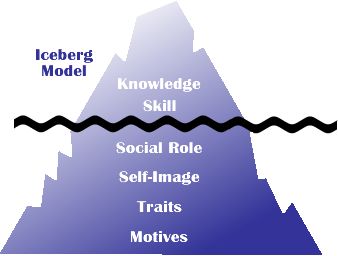The relationship between technical and behavioral success factors is an interactive one. That is, overall performance is the result of having both the needed job knowledge and the ability to apply that knowledge effectively to fulfill the expectations of the job or role.
Technical:
Behavioral:
One of the easiest ways to show the relationship of the components of the success factors is to picture an iceberg. Above the waterline is the technical knowledge a person has about something. Closer to the waterline is skill, i.e., the ability to perform a physical or technical task, such as financial analysis, or a cognitive task, such as problem solving. It is relatively easy to see people performing the physical tasks, and, consequently, to assess them. Those skills closer to, or just below, the waterline are more difficult to assess. For example, with problem solving you can see the solution, but you cannot necessarily see the thought process.

Social Role
Social role relates to how we project ourselves, our outer self, the image we want to project. For example, some doctors may project the image of EXPERT by focusing on how much they know about a particular specialty or how much skill they have at a specific function. Others may project the image of HELPER by focusing on what they can do for others. How we choose to project ourselves to others influences where we put our emphasis in performing our roles.
Self-Image
Self-image gets at our attitudes and values and relates to the feelings we have about ourselves, and what is important to us as individuals, our inner-self. For example, if a person has an attitude or value that serving customers is important, that person may be more likely to answer repeated requests for information and assistance than someone else who doesn't share the same attitudes and values. Another example of self-image is a person's level of self-confidence.
Traits
Traits are the characteristics or consistent/habitual ways of responding in a variety of situations such as attention to detail and quality and self-control. Certain jobs or roles require certain traits. For example, if the job or role involves defusing highly emotional situations and therefore requires a great deal of self-control, you would look for someone who consistently demonstrates that trait when selecting candidates.
Motives
Motives are deep-rooted and formed early in life. They are the things a person consistently thinks about or wants that cause them to take action. For example, someone who is highly achievement-motivated will always strive to do a better job. Someone who is highly social and is driven by an affiliation motive may be better suited to a role that involves dealing with people as their emphasis will be on building and maintaining positive relationships.